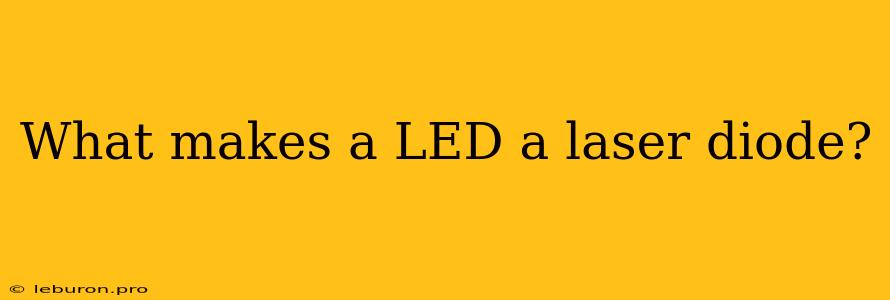The world of light-emitting diodes (LEDs) has revolutionized illumination, offering energy efficiency and longevity compared to traditional incandescent bulbs. But within this realm of LEDs lies a specialized subset—laser diodes. While both emit light, the difference between a standard LED and a laser diode lies in the way they generate and control the emitted light. This article delves into the key distinctions, exploring the factors that make a LED a laser diode, highlighting its unique properties and applications.
From LEDs to Laser Diodes: The Underlying Physics
Both LEDs and laser diodes are based on the principle of electroluminescence, where electrons recombine with holes within a semiconductor material, releasing energy in the form of light. However, the crucial difference lies in the nature of the emitted light:
- LEDs: Emit light in a broad range of wavelengths, producing incoherent light that spreads out in all directions. The light emitted by an LED is typically visible to the human eye, encompassing a wide range of colors.
- Laser Diodes: Generate highly coherent and monochromatic light, meaning the light waves are in phase and have a single, specific wavelength. This highly focused and directional beam of light is what makes lasers distinct.
The Power of Stimulated Emission
To understand the difference, we need to delve into the process of stimulated emission. In a typical LED, electrons in the semiconductor material spontaneously recombine with holes, emitting photons randomly. This process leads to the incoherent light we see from an LED.
In contrast, a laser diode uses a phenomenon called stimulated emission. In this process, an excited electron in the material is triggered by an incoming photon of the same energy level to release a photon. This emitted photon is identical to the incoming photon in terms of energy, direction, and phase.
The Resonant Cavity
The stimulated emission in a laser diode occurs within a special structure called a resonant cavity. This cavity is created by two highly reflective mirrors placed at the ends of the active region of the semiconductor material. The mirrors reflect the emitted photons back and forth, allowing them to interact with the excited electrons and induce further stimulated emission. This process amplifies the light, resulting in a highly focused and coherent laser beam.
Key Properties Differentiating LEDs and Laser Diodes
The following table summarizes key properties distinguishing LEDs and laser diodes:
| Feature | LED | Laser Diode |
|---|---|---|
| Light Emitting Principle | Spontaneous emission | Stimulated emission |
| Wavelength | Broad range | Single, specific wavelength |
| Coherence | Incoherent | Coherent |
| Directionality | Spreads out in all directions | Highly directional |
| Power | Lower power | Higher power |
| Applications | General lighting, displays | Laser pointers, optical communication, medical devices, industrial processes |
Applications of Laser Diodes: Harnessing the Power of Coherence
The unique properties of laser diodes make them suitable for a diverse range of applications, some of which include:
- Optical Communication: Laser diodes are essential in fiber optic communication systems, transmitting data over long distances with high bandwidth and minimal signal loss.
- Laser Scanners: From barcode scanners to laser printers, laser diodes are used to read information encoded in patterns.
- Medical Devices: Laser surgery, diagnostics, and therapy utilize the precision and power of laser diodes for minimally invasive procedures.
- Industrial Processes: Laser cutting, welding, and engraving are made possible by the focused and intense beam of light generated by laser diodes.
Conclusion: The Significance of Laser Diodes
Laser diodes, a specialized type of LED, have revolutionized various industries, proving essential in areas ranging from communication and healthcare to manufacturing. Their ability to emit coherent and monochromatic light opens a vast array of possibilities, pushing the boundaries of technology. As research and development continue, we can expect to see even more innovative applications of laser diodes in the future, shaping our world with their remarkable properties.
